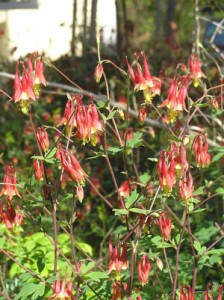Another “regular, irregular†Carolina Piedmont spring
By Ken Moore
Flora Columnist
It’s spring again in the Carolina Piedmont. That means another round of predictably unpredictable weather that sets serious and not-so-serious gardeners into an annual frenzy. Over the years I’ve come to anticipate that when the exotic Star magnolias and the Bradford pears come into flower it’s time for the typical Carolina Piedmont killing frost. That didn’t occur this year. Global warming, hmmm? The killing frosts came later this year. I have also observed that our native species are generally not significantly bothered by these “regular, irregular†cold spells following really warm periods in early spring. Only once during my time (a sorta long time), back in the early 1980s, do I recall that native plants have been harmed by a late spring freeze. I remember, during a Wildflower Society excursion in the Charlotte area, that a late freeze had killed back the fresh fiddleheads of Christmas ferns and all along Interstate 85 the new leaves of the oak trees were blackened. That was the only time in my lifetime.
I have always sounded off in favor of gardening with native plants if you want to avoid disappointment during the “regular, irregular’ Piedmont spring freezes. I still hold strongly to this philosophy. But I am truly humbled by this past weekend. In an earlier column for The Carrboro Citizen, I had predicted this past weekend’s cold spell to occur a week earlier. I was off, though my announcement of the April 10th peak of Dogwood flowering is still fairly accurate. This past weekend’s low temperatures have significantly reduced my sour (pie) cherry crop. And, thankfully, much of the Chinese Wisteria, strangling numerous trees along my border, has been harmed, so hopefully fewer seed will be produced to spread this tree-strangling pest onto other grounds.
On Sunday afternoon I traveled the local environs to check on the weekend’s frost damage, eager to once again observe the superior hardiness of our native plants that over thousands of years of being here are well-adapted to surviving such challenging weather patterns. I visited my favorite garden, a little “postage stamp†of horticultural exuberance, the front-door garden of Chapel Hill resident Bill Bracey, whose “Shelby’s Bottom†sunken garden on Hillsborough Road is right now a little spectacle of the native columbine (Aquilegia canadensis). None of these red and yellow flowers, beckoning the return of the hummingbirds, were ill-effected by the frost. I was ecstatic. Once again my theory about natives was holding true. Then Bill emerged from his front door to make me aware that not only had his so-called hardy non-native kiwi fruit been “burned†by the cold, but we both surprisingly observed “burnt†tender leaves and flower buds on his native Fringe tree, as well as on the numerous native Paw Paw trees strategically sited around his modest landscape. Curiously, only half of his Paw Paw flowers were damaged and hopefully the Fringe trees will recover with some flowering for this spring. Returning home on the western edge of Carrboro, I realized that the new foliage at the tips of some of the branches of my several volunteer Redbuds had been damaged by the low Saturday night temperatures, but the effect seemed minimal.
This is one of those dramatic springs, occurring every other decade or so, that damages some of our native plants, in addition to many of our exotic ornamental plants and early fruit crops. There are lessons, however, for all of us:
Our Piedmont springs always have harmful freezes following really warm spells in March and into mid-April.
Our native plants rarely suffer and they recover quickly.
We should avoid the enthusiasm and disappointment of planting out tender annuals and summer veggies until the soil temperature really warms up in early to mid-May. But then there are those of us who really enjoy planting out, again and again, in the early spring, what we have come to recognize as “sacrificial†tomatoes and marigolds. Garden centers love us because we purchase the same plants two or three times each season. Helps their cash flow.
In the meantime, hey, it’s spring; enjoy another walk in the woods. The wildflowers there have been little affected by the “regular, irregularities†of the weather we have in the spring in the Carolina Piedmont.
Email Ken Moore at flora@carrborocitizen.com.



Comments are closed.